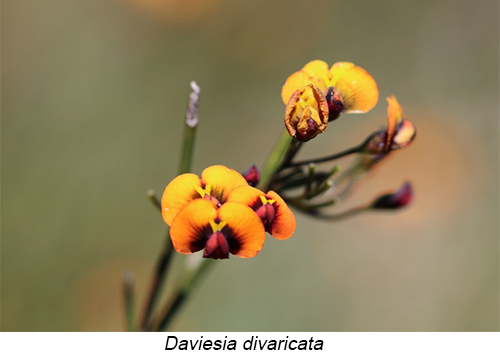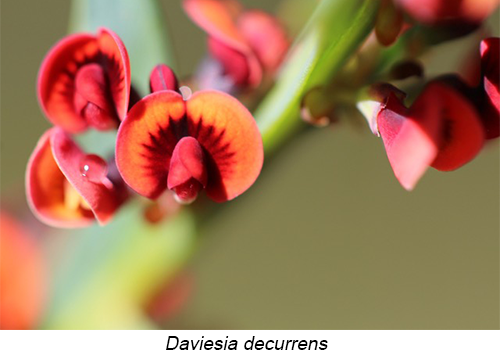<< BACK TO PROJECT LIST
Project: 308/2016
Title: Pollination biology of Diuris: testing for Batesian mimicry in Southwestern Australia.
Applicant: Daniela Scaccabarozzi
Institution: Department of Environment and Agriculture, Curtin University; Kings Park and Botanic Gardens, Western Australia.
Batesian floral mimicry has been suggested in some orchids which appear to imitate flowers of sympatric rewarding species in order to attract the pollinators. The Donkey orchids are a temperate Australian genus of nectarless orchids (Diuris) whose pollination has never been studied before in Western Australia even though these are common, diverse and widespread orchids. Diuris spp. have long been hypothesised to deceive native bees into visiting their flowers through mimicking food-rewarding native pea plants (Fabaceae), particularly those locally known as ‘egg and bacon plants’, which belong to several genera with yellow and purple-brown flowers. Diuris co-occur with some species of pea plants, blooming throughout winter/spring and exhibit similar floral aspects, such as colour and morphology. This study focuses on the pollination biology of Diuris in natural bushland near and around Perth, with the aim of understanding the pollination biology of both groups of plants, and testing for Batesian floral mimicry between the orchid and host pea plants.
Being the first detailed test of the mimicry hypothesis in Australia, and one of the first detailed studies in Australia pea plants despite their immense diversity, the study will enhance our understanding of pollination biology within orchids and legumes plants. This will be the first study of its type in the southwest Australian biodiversity hotspot, also one of the richest regions for terrestrial orchids, that will systematically test the efficacy of the food deception syndrome in orchids to compliment the intensive studies done to date on sexual deception syndromes in southwest Australian orchids. Further, the research will greatly increase the data available regarding the ecology of pollinators, with potential benefits for the management of endangered orchid species and threatened legumes that share the same pollinators. In particular, the field vegetation evaluations will contribute to the understanding of the relationship between reproduction success of Diuris and other members of the plant community.

The project tests for a unique pollination system in the Australian orchid genus Diuris via floral mimicry of multiple pea plants (Faboideae). In order to frame the pollination ecology of the putative model pea plants, we also verify the type of pollinator interaction occurring in communities of pea plants in the Southwestern Australian Floristic Region (SWAFR). Our findings support one of the rare confirmed case of guild mimicry in plant world, suggesting that Diuris represents a useful system for investigating speciation in lineages that employ mimicry of food plants.
Research outcomes:
We have presented a comprehensive evaluation of the mimicry for the Diuris-pea plants system. In addition to meeting the criteria for sharing pollinators and flowering times, pollinators exhibited the same foraging behaviour on both Diuris and pea plants, providing strong evidence that the mimetic orchid had successfully deceived the pollinator. This evidence was further supported by data on morphology and colour, showing that not only are Diuris and pea plants are very similar compared to the remainder of the co-flowering community, but that based on bee vision models, in many cases the colour of Diuris and the proposed model species will not be readily distinguishable to pollinators. Pollination success of Diuris brumalis was greater in presence of Daviesia (Faboideae), though evidence suggests that this is likely through some combination of both learning, and greater pollinator abundance at sites where the model is present. Alternatively, the pollination success of Diuris magnifica was independent by the putative model species, while was influenced by the presence of a non-model species, Hardenbergia comptoniana, a magnet species. Overall, factors related to mimicry, numbers of co-flowering plants, and anthropogenic landscape alteration affected the pollination success of D. magnifica.
The results of this work that are currently under submission for publication, have been also presented at the IOCC – International Orchid Conservation Conference, Kew, UK, 28 May-1 June 2019, at the national Symposium of the Royal Society of Western Australia, Perth, 28-29 July 2018, and on Youtube: https://www.youtube.com/watch?v=2PGk4FCV7Y8. View video below
Published papers arising from this research:
D Scaccabarozzi, S Cozzolino, L Guzzetti, A Galimberti, L Milne, KW Dixon and RD Phillips. Masquerading as pea plants: behavioural and morphological evidence for mimicry of multiple models in an Australian orchid. 2018. Annals of botany 122, 1061-107.




Scaccabarozzi D, Guzzetti L Phillips R, Milne L, Tommasi N, Cozzolino S and Dixon KW. Ecological factors driving pollination success in an orchid that mimics a range of Fabaceae. Botanical Journal of the Linnean Society, 2020, XX 1-17.
Scaccabarozzi D, Cozzolino S, Guzzetti L, Galimberti A, Milne L, Dixon KW, and Phillips R. Masquerading as pea plants: behavioural and morphological evidence for mimicry of multiple models in an Australian orchid. Annals of Botany 122: 1061-1073, 2018.
Scaccabarozzi D, Galimberti A, Dixon KW and Cozzolino S. Rotating Arrays of Orchid Flowers: A Simple and Eective Method for Studying Pollination in Food Deceptive Plants. Diversity 2000, 12,286: doi:10.3390/d12080286
